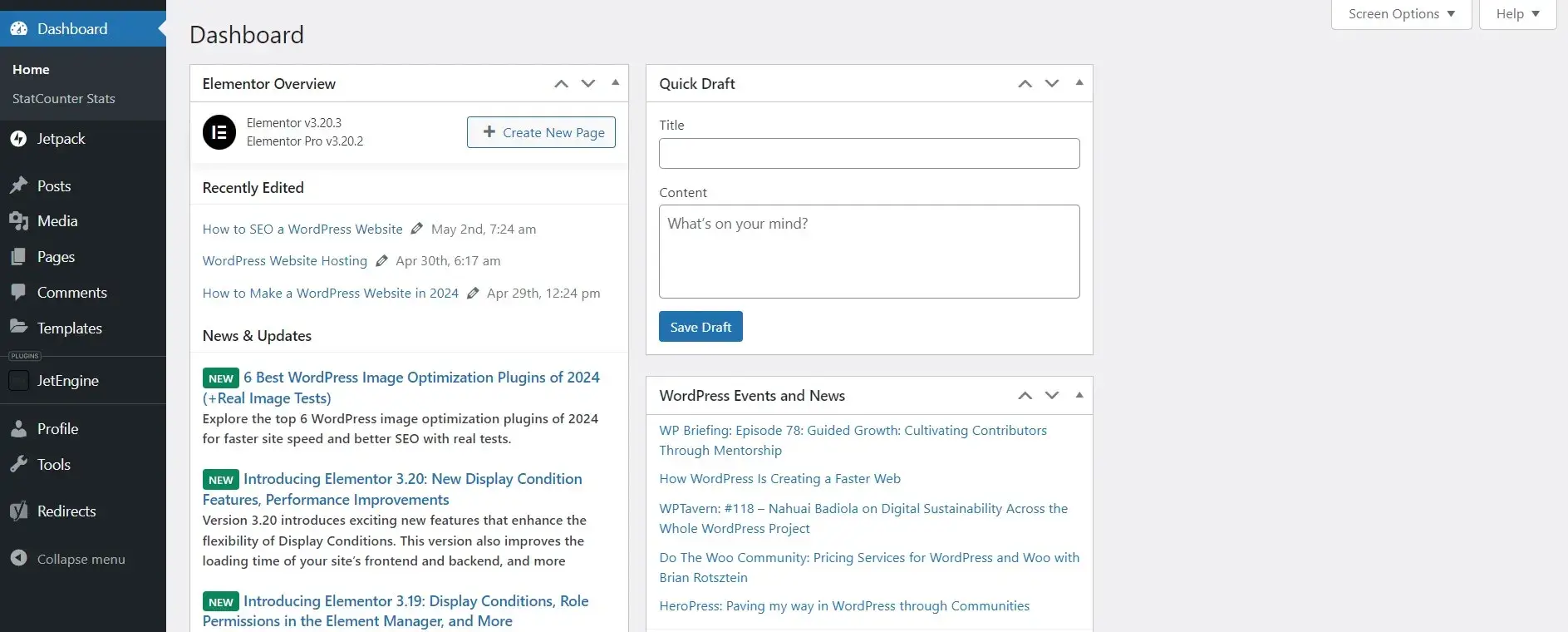Importance of a WordPress Website in 2024

WordPress stands as a titan in the realm of website development platforms, renowned for its user-friendly interface and robust features. Powering over 40% of all websites on the internet, WordPress has solidified its position as the go-to choice for individuals and businesses alike. Its intuitive content management system empowers users to create and customize websites with ease, whether they’re novices or seasoned developers.
In the digital age of 2024, having a website is not just advantageous—it’s essential. As the world becomes increasingly interconnected, consumers turn to the internet to discover, research, and engage with businesses and brands. A website serves as your digital storefront, offering a 24/7 platform to showcase your products, services, and expertise to a global audience. In today’s competitive landscape, a strong online presence can mean the difference between success and obscurity.
The purpose of this article is simple yet vital to guide readers through the process of creating a WordPress website in 2024. Whether you’re a budding entrepreneur, a passionate blogger, or a seasoned professional looking to expand your online footprint, we’re here to provide you with the knowledge and tools you need to build and launch your website confidently. So let’s dive in and turn your digital dreams into reality.
Why Choose WordPress in 2024?
Proven Popularity and Reliability
WordPress stands as a beacon of reliability and popularity in the realm of website development platforms. With its long-standing presence and continuous updates, WordPress has garnered trust from millions of users worldwide. Its robust infrastructure ensures stable performance, making it a dependable choice for creating websites of all types and sizes.
Unmatched Flexibility and Scalability
One of the key advantages of WordPress is its unparalleled flexibility and scalability. Whether you’re building a personal blog, an e-commerce site, or a corporate portal, WordPress adapts seamlessly to your needs. Its modular architecture allows for effortless expansion, enabling your website to grow alongside your business or project without constraints.
Endless Customization Possibilities
WordPress boasts an extensive array of themes and plugins, offering limitless customization possibilities. Whether you’re aiming for a sleek and modern design or a bold and creative layout, you’ll find a theme to match your vision. Additionally, plugins enhance functionality, allowing you to add features and functionalities tailored to your specific requirements without the need for custom development.
Dominance in the CMS Market
Statistics and trends underscore WordPress’s dominance in the CMS market. With over 40% of websites powered by WordPress, it maintains a significant lead over its competitors. Its widespread adoption is a testament to its effectiveness and versatility, reaffirming its status as the platform of choice for website creation in 2024.
Getting Started with WordPress
Securing Your Domain and Hosting
Before diving into WordPress, the first step is to secure a domain name and hosting service. Your domain name is your website’s address on the internet, while hosting provides the server space where your website files are stored. Opt for reputable hosting providers like Bluehost, which offer reliable services and user-friendly interfaces for seamless website management.
Installation of WordPress
With your domain and hosting sorted, it’s time to install WordPress. Many hosting providers offer a convenient one-click installation method, simplifying the process even for beginners. Log in to your hosting account’s control panel, navigate to the “WordPress” section, and follow the prompts to install WordPress on your domain. Within minutes, your website will be up and running, ready for customization.
Refer to this article on How to Install WordPress for detailed guidance on the installation process.
Navigating the WordPress Dashboard

Upon successful installation, you’ll gain access to the WordPress dashboard, your website’s command centre. Here, you’ll find many tools and features to manage and customize your website. The dashboard is divided into several sections, including:
Posts: Create and manage blog posts or articles for your website.
Pages: Add and edit static pages, such as the homepage, about page, and contact page.
Media: Upload and manage images, videos, and other media files for your website.
Appearance: Customize your website’s appearance by selecting themes, customizing menus, and managing widgets.
Plugins: Extend the functionality of your website by installing and activating plugins for various purposes.
Settings: Configure essential settings for your website, such as site title, tagline, permalinks, and reading preferences.
Take some time to familiarize yourself with the WordPress dashboard and its key features. Experiment with different settings and options to understand how they affect your website’s appearance and functionality. With a solid understanding of the dashboard, you’ll be well-equipped to embark on your WordPress website creation journey with confidence.
Refer to this article on How WordPress Works for a better understanding of WordPress and its features.
Choosing a Theme
The Significance of Theme Selection
Your website’s theme serves as its visual identity, shaping visitors’ first impressions and influencing their overall experience. Choosing a suitable theme is crucial for effectively conveying your brand message and engaging your audience. Whether you’re aiming for a professional corporate look or a vibrant and creative design, selecting the right theme lays the foundation for your website’s success.
Factors to Consider
Design: Opt for a theme with a design aesthetic that aligns with your brand identity and target audience preferences. Look for clean layouts, attractive typography, and visually appealing elements that enhance user engagement.
Responsiveness: In today’s mobile-centric world, responsive design is non-negotiable. Ensure that the theme you choose is fully responsive, meaning it adapts seamlessly to various screen sizes and devices. This guarantees a consistent and user-friendly experience for all visitors, regardless of the device they’re using.
Customization Options: Flexibility is key when it comes to theme customization. Seek out themes that offer ample customization options, allowing you to personalize colors, fonts, layouts, and more to suit your specific needs. Look for themes compatible with popular page builders like Elementor or WPBakery for added flexibility without coding.
Exploring Theme Marketplaces
ThemeForest: As one of the largest theme marketplaces, ThemeForest offers a vast selection of premium WordPress themes catering to diverse industries and niches. Browse through thousands of themes, filter by category and features, and read user reviews to find the perfect fit for your website.
WordPress Theme Directory: For those on a budget, the WordPress Theme Directory provides a lot of free themes developed and vetted by the WordPress community. While free themes may have limited features compared to premium options, they still offer excellent quality and customization options for beginners and small businesses.
Additional Tips
Demo Sites: Before committing to a theme, explore its demo site to get a feel for its design and functionality. Test different features and layouts to ensure they meet your requirements.
Support and Updates: Choose themes from reputable developers who offer regular updates and reliable customer support. This ensures compatibility with the latest WordPress versions and timely assistance in case of any issues or questions.
By carefully considering these factors and exploring reputable theme marketplaces, you’ll be well-equipped to select a theme that elevates your website and sets the stage for success.
Ready to elevate the design of your WordPress website? Explore our curated selection of themes and unlock the potential to captivate your audience with stunning visuals and seamless functionality. Don’t settle for mediocrity – contact us now to discover the perfect theme for your website and make a lasting impression online.
Transform Your Online Presence with Stunning Web Designs

Customizing Your Website
Exploring the WordPress Customizer
The WordPress Customizer is a powerful tool that allows you to personalize your website’s appearance in real time. Accessed through the WordPress dashboard, the Customizer provides an intuitive interface for making visual changes to your website without affecting its underlying code. Let’s delve into how you can harness the Customizer to tailor your website to your preferences.
Customization Options
Logo Upload: Begin by uploading your logo to establish brand identity and recognition. Navigate to the Customizer’s “Site Identity” section, where you can easily upload your logo and adjust its size and placement to seamlessly integrate it into your website’s design.
Color Schemes: Customize your website’s color scheme to reflect your brand’s personality and style. Within the Customizer, navigate to the “Colors” section, where you can select primary and accent colors to apply across various elements of your website, such as headers, backgrounds, buttons, and more.
Typography: Typography plays a crucial role in shaping your website’s visual appeal and readability. Use the Customizer’s typography settings to choose fonts for headings, body text, and other elements. Experiment with different font pairings and styles to find the perfect combination that enhances your website’s aesthetics and legibility.
Leveraging Page Builders
For those seeking more advanced customization options beyond what the Customizer offers, page builders like Elementor provide a user-friendly solution. With drag-and-drop functionality and a library of pre-designed elements and templates, Elementor empowers you to create custom layouts and designs without any coding knowledge.
Creating Custom Layouts: With Elementor, you can design custom layouts for individual pages or sections of your website. Simply drag elements like text boxes, images, buttons, and widgets onto your canvas and arrange them to your liking.
Styling Elements: Customize the appearance of each element using Elementor’s styling options. Adjust fonts, colors, sizes, margins, and more with ease to achieve the desired look and feel for your website.
Adding Dynamic Content: Elementor also allows you to incorporate dynamic content such as blog posts, portfolios, and testimonials into your designs. Utilize dynamic widgets to display recent posts, featured products, or customer reviews dynamically, keeping your website fresh and engaging.
Adding Essential Plugins
Understanding the Role of Plugins
Plugins are essential tools that extend the functionality of your WordPress website beyond its core features. They serve as add-ons or modules that can be installed and activated to perform specific tasks or add new features. Whether you need to improve SEO, enhance security, or optimize performance, there’s likely a plugin available to meet your needs.
Recommended Essential Plugins
SEO (Yoast SEO): Yoast SEO is a must-have plugin for optimizing your website’s search engine visibility. It offers features such as on-page optimization, XML sitemap generation, and content analysis to help improve your website’s rankings in search engine results.
Security (Wordfence Security): Protecting your website from cyber threats is paramount, and Wordfence Security is an excellent tool for the job. This comprehensive security plugin offers features like firewall protection, malware scanning, login security, and real-time threat defense to keep your website safe and secure.
Performance Optimization (WP Rocket): WP Rocket is a powerful caching plugin that helps improve your website’s speed and performance. By caching static content, optimizing images, and implementing lazy loading, WP Rocket reduces page load times and enhances the overall user experience.
Importance of Selective Plugin Installation
While plugins can significantly enhance your website’s functionality, it’s crucial to exercise caution and install only necessary plugins to avoid bloating your website. Each plugin you add introduces additional code and potential compatibility issues, which can impact your website’s performance and security. Before installing a plugin, carefully evaluate its necessity and functionality, and consider whether its features can be achieved through alternative means or by utilizing existing plugins.
By judiciously selecting and installing essential plugins like Yoast SEO, Wordfence Security, and WP Rocket, you can enhance your website’s functionality, security, and performance without compromising its integrity. Remember to prioritize quality over quantity when it comes to plugins and regularly review and optimize your plugin selection to ensure optimal website performance.
Refer to this article on How WordPress Plugins Work for a better understanding of the use of plugins in your WordPress website.
Creating Compelling Content

Understanding the Impact of High-Quality Content
High-quality content serves as the backbone of your website, captivating visitors and driving engagement. Not only does it provide value to your audience, but it also plays a crucial role in improving your website’s search engine rankings. By offering informative, relevant, and engaging content, you can establish credibility, foster trust with your audience, and encourage them to return for more.
Exploring Content Types
Pages: Pages are static content sections of your website that provide essential information about your business, services, or products. Common pages include the homepage, about page, contact page, and services/products page.
Blog Posts: Blog posts are dynamic content pieces that allow you to share news, insights, tips, and stories with your audience. They provide an opportunity to showcase your expertise, connect with your audience on a deeper level, and drive organic traffic to your website.
Multimedia: Incorporating multimedia elements such as images, videos, infographics, and audio clips can enhance the visual appeal and engagement of your content. Multimedia content not only breaks up text but also provides alternative ways for your audience to consume information.
Optimizing Content for SEO and Readability
Keyword Optimization: Conduct keyword research to identify relevant keywords and phrases that your target audience is searching for. Incorporate these keywords naturally into your content, including headings, subheadings, and body text, to improve your website’s visibility in search engine results.
Structure and Formatting: Organize your content with clear headings and subheadings to improve readability and user experience. Use bullet points, numbered lists, and short paragraphs to break up text and make it easier to digest. Additionally, use descriptive meta titles and meta descriptions to entice users to click through to your content from search engine results pages.
Quality and Value: Focus on providing valuable, informative, and unique content that addresses the needs and interests of your target audience. Avoid duplicating content or engaging in keyword stuffing, as these practices can harm your website’s SEO and credibility.
Setting Up Essential Pages
Key Pages Overview
To create a comprehensive and user-friendly website, it’s essential to include certain key pages that serve as pillars of information and engagement. These pages include:
Home: The homepage is the gateway to your website and often the first impression visitors have of your brand. It should provide a brief overview of your business or organization and guide visitors to other relevant sections of your website.
About: The about page offers an opportunity to tell your brand story, share your mission and values, and showcase your team or leadership. It helps build trust and credibility with your audience by providing insight into the people behind the brand.
Contact: The contact page is where visitors can reach out to you directly. Include contact information such as your email address, phone number, and physical address, as well as a contact form for convenience.
Services/Products: If you offer services or sell products, dedicate a page to showcasing them in detail. Provide descriptions, pricing information, and compelling visuals to entice visitors to learn more and make a purchase.
Structuring and Formatting Guidance
Clear Navigation: Ensure that your website’s navigation menu prominently features links to each essential page, making it easy for visitors to find the information they’re looking for.
Engaging Content: Each page should be structured in a way that is visually appealing and easy to digest. Use headings, subheadings, bullet points, and images to break up text and make the content more scannable.
Consistent Branding: Maintain consistent branding across all essential pages, including color schemes, typography, and imagery. This helps reinforce your brand identity and creates a cohesive user experience.
Call-to-Action: Incorporate clear calls-to-action (CTAs) on each page to prompt visitors to take the next step, whether it’s contacting you for more information, signing up for a newsletter, or making a purchase.
Mobile Responsiveness: Ensure that your essential pages are optimized for mobile devices, as an increasing number of users access websites on smartphones and tablets. Test your pages on various devices to ensure they display properly and function seamlessly.
Optimizing for SEO

The Significance of SEO
In the competitive digital landscape of 2024, SEO (Search Engine Optimization) plays a pivotal role in enhancing your website’s visibility and attracting organic traffic. By optimizing your website for search engines, you increase the likelihood of ranking higher in search engine results pages (SERPs), making it easier for potential customers to discover your website and content.
On-Page SEO Best Practices
Keyword Research: Conduct thorough keyword research to identify relevant terms and phrases that your target audience is searching for. Focus on long-tail keywords with moderate to high search volume and low competition. Incorporate these keywords naturally into your website’s content, including headings, subheadings, meta titles, and meta descriptions.
Meta Tags Optimization: Optimize meta tags, including meta titles and meta descriptions, to improve click-through rates and search engine visibility. Craft compelling and concise meta titles that accurately reflect the content of each page and include relevant keywords. Similarly, write informative meta descriptions that entice users to click through to your website.
Content Organization: Organize your website’s content in a logical and hierarchical manner, with clear headings, subheadings, and bullet points to improve readability and user experience. Use descriptive URLs and optimize image alt text to provide additional context to search engines and improve accessibility.
SEO Plugins and Tools
Yoast SEO: Yoast SEO is a comprehensive WordPress plugin that provides a range of features to optimize your website for search engines. It offers on-page analysis, content readability checks, XML sitemap generation, and more, making it an indispensable tool for SEO optimization.
Google Keyword Planner: Google Keyword Planner is a free tool provided by Google that allows you to research keywords, analyze search volume and competition, and identify valuable keyword opportunities for your website.
SEMrush: SEMrush is a powerful SEO tool suite that offers features such as keyword research, competitive analysis, backlink analysis, and site auditing. It provides valuable insights and data to help you identify and implement effective SEO strategies.
Ensuring Website Security
The Criticality of Website Security
In the digital landscape of 2024, website security is of foremost importance. With cyber threats evolving and becoming more sophisticated, protecting your WordPress website against vulnerabilities is essential to safeguarding your data, reputation, and the trust of your users. Ensuring robust website security measures is not only a proactive approach but also a necessity in today’s interconnected world.
Shielding Against Common Threats
Malware Protection: Implement robust malware protection measures to prevent malicious software from compromising your website’s integrity. Regularly scan your website for malware using security plugins and tools, and promptly remove any detected threats.
Strong Passwords: Enforce strong password policies for user accounts, including administrators, editors, and contributors. Encourage the use of complex passwords that include a combination of letters, numbers, and special characters to minimize the risk of unauthorized access.
Secure Hosting: Choose a reputable and secure hosting provider that prioritizes website security and offers features such as SSL encryption, server-level security measures, and regular backups. A secure hosting environment forms the foundation of your website’s security posture.
Updates and Patches: Keep your WordPress core, themes, and plugins up to date with the latest security patches and updates. Vulnerabilities in outdated software are often exploited by attackers to gain unauthorized access or inject malicious code into your website.
Recommended Security Practices and Tools
Wordfence Security: Wordfence Security is a popular WordPress security plugin that offers features such as firewall protection, malware scanning, login security, and real-time threat defense. It helps proactively safeguard your website against a wide range of security threats and vulnerabilities.
Regular Backups: Implement regular backup procedures to ensure that you have a recent and clean copy of your website’s data in case of a security incident or data loss. Backup your website files and database regularly, and store backups securely offsite or in the cloud.
Security Audits and Monitoring: Conduct regular security audits and monitoring to identify and address potential vulnerabilities before they can be exploited by attackers. Utilize security plugins and tools to monitor website activity, detect suspicious behavior, and block malicious IPs and traffic.
By implementing comprehensive security measures, staying vigilant against emerging threats, and utilizing security plugins and practices for regular maintenance and monitoring, you can fortify your WordPress website against common threats and ensure its continued protection in 2024 and beyond. Remember that website security is an ongoing process that requires proactive measures and continuous attention to mitigate risks effectively.
Concerned about the security of your WordPress website in today’s digital climate? Our team specializes in fortifying websites against common threats like malware and hacking attempts. Take proactive steps to safeguard your online presence, contact us today for personalized security solutions and ensure your website remains resilient against cyber threats.

Ignite Your Digital Presence
Testing and Launching Your Website
Prioritizing Comprehensive Testing
Before unveiling your website to the world, thorough testing is paramount to ensure a seamless and error-free user experience. Rushing to launch without adequate testing can result in functionality issues, compatibility problems, and ultimately, a negative impression on your audience. Take the time to rigorously test every aspect of your website to identify and address any potential issues proactively.
Methods for Testing Website Performance
Functionality Testing: Verify that all website features and functionalities are working as intended. Test forms, buttons, links, navigation menus, and interactive elements to ensure they function correctly across different browsers and devices.
Responsiveness Testing: Assess your website’s responsiveness across various screen sizes and resolutions, including desktops, laptops, tablets, and smartphones. Use tools like Google’s Mobile-Friendly Test and browser developer tools to simulate different devices and identify any layout or display issues.
Compatibility Testing: Test your website’s compatibility across different web browsers, including Chrome, Firefox, Safari, Edge, and Internet Explorer. Ensure that your website renders consistently and functions properly across all major browsers to provide a seamless experience for users regardless of their browser preference.
Final Pre-Launch Checklist
Content Review: Double-check all content, including text, images, and multimedia, for accuracy, relevance, and consistency. Ensure that all links are working correctly and lead to the intended destination.
SEO Optimization: Verify that meta titles, meta descriptions, and heading tags are optimized for relevant keywords and accurately reflect the content of each page. Test social media sharing functionality to ensure that shared links display correctly.
Performance Optimization: Optimize website performance by minifying CSS and JavaScript files, optimizing images, and enabling caching mechanisms. Test page load times using tools like Google PageSpeed Insights or GTmetrix and address any performance bottlenecks.
Security Measures: Implement security measures such as SSL encryption, firewall protection, and security plugins to protect your website from cyber threats. Conduct security audits to identify and address any vulnerabilities or weaknesses.
Backup Procedures: Establish a backup procedure to create a backup of your website files and database before launching. Store backups securely offsite or in the cloud to ensure data integrity and resilience against potential data loss or security breaches.
Maintaining Your WordPress Website
Recognizing the Importance of Ongoing Maintenance
Maintaining your WordPress website is not a one-time task but an ongoing commitment essential for ensuring optimal performance, security, and reliability. Regular maintenance routines are imperative to address potential vulnerabilities, keep your website up to date with the latest technologies, and provide a seamless experience for your visitors.
Essential Maintenance Tasks
Updating WordPress Core: Keep your WordPress core updated to the latest version to benefit from security patches, bug fixes, and new features. WordPress releases regular updates to enhance performance and address vulnerabilities, so it’s crucial to stay current with the latest releases.
Updating Themes and Plugins: Regularly update your themes and plugins to ensure compatibility with the latest WordPress version and mitigate security risks. Outdated themes and plugins are often targeted by hackers, making them a potential entry point for security breaches.
Regular Backups: Implement a robust backup strategy to safeguard your website’s data in case of emergencies or unforeseen circumstances. Schedule regular backups of your website files and database, and store backups securely offsite or in the cloud for added resilience.
Resources for Learning and Support
WordPress Codex: The WordPress Codex is a comprehensive online resource that provides documentation, guides, and tutorials covering various aspects of WordPress maintenance, development, and troubleshooting. It serves as a valuable reference for beginners and experienced users alike.
WordPress Community Forums: Engage with the WordPress community forums to seek advice, share experiences, and troubleshoot issues related to website maintenance. The community forums offer a wealth of knowledge and support from fellow WordPress users and experts.
WordPress Blogs and Websites: Explore reputable WordPress blogs and websites that specialize in providing tips, tutorials, and best practices for website maintenance and optimization. Stay updated with the latest trends, techniques, and tools to keep your WordPress website running smoothly.
Online Courses and Workshops: Enroll in online courses or workshops that offer in-depth training on WordPress maintenance best practices, security measures, and performance optimization strategies. Platforms like Udemy, Coursera, and LinkedIn Learning offer a wide range of courses tailored to different skill levels and interests.
FAQs
WordPress is a popular content management system (CMS) used to create websites, blogs, and online stores. It offers flexibility, scalability, and a wide range of themes and plugins for customization. In 2024, WordPress remains a top choice for website development due to its user-friendly interface, robust features, and extensive community support.
When selecting a theme for your WordPress website, consider factors such as design aesthetics, responsiveness, customization options, and compatibility with plugins. Browse reputable theme marketplaces like ThemeForest and the WordPress theme directory, and explore demo sites to preview themes before making a decision.
Essential plugins enhance your website’s functionality and performance. For tasks such as SEO, security, and performance optimization, consider installing plugins like Yoast SEO, Wordfence Security, and WP Rocket. However, be cautious not to install too many plugins, as this can affect your website’s speed and security.
To optimize your WordPress website for search engines, focus on on-page SEO practices such as keyword research, meta tags optimization, and content organization. Utilize SEO plugins like Yoast SEO to streamline optimization efforts and monitor your website’s performance in search engine rankings.
Before launching your WordPress website, ensure thorough testing for functionality, responsiveness, and compatibility across devices and browsers. Create essential pages such as Home, About, Contact, and Services/Products, and optimize them for SEO and user experience. Finally, follow a pre-launch checklist to address any issues and ensure a smooth launch process.
Conclusion
In the dynamic landscape of 2024, WordPress continues to shine as a versatile platform for crafting engaging online experiences. Throughout this guide, we’ve explored the vital role WordPress plays in establishing a strong online presence, covering essential topics like theme selection, SEO optimization, and security.
From choosing themes and essential plugins to optimizing content and ensuring website security, we’ve equipped you with the tools to create a successful WordPress website. By prioritizing quality content, user experience, and ongoing maintenance, you can enhance your website’s performance and attract organic traffic.
As you embark on your WordPress journey, remember to stay informed and adaptable. Whether you’re a seasoned user or new to WordPress, the potential for creativity is limitless. If you have questions or need assistance with your WordPress project, don’t hesitate to contact us. Our team is here to support you every step of the way. Let’s build something extraordinary together.
Unlock Your Online Potential with Expert WordPress Design
Empower your business with our bespoke WordPress web design solutions. Elevate your brand’s digital presence, seamlessly blending functionality and aesthetics for unparalleled online success.





